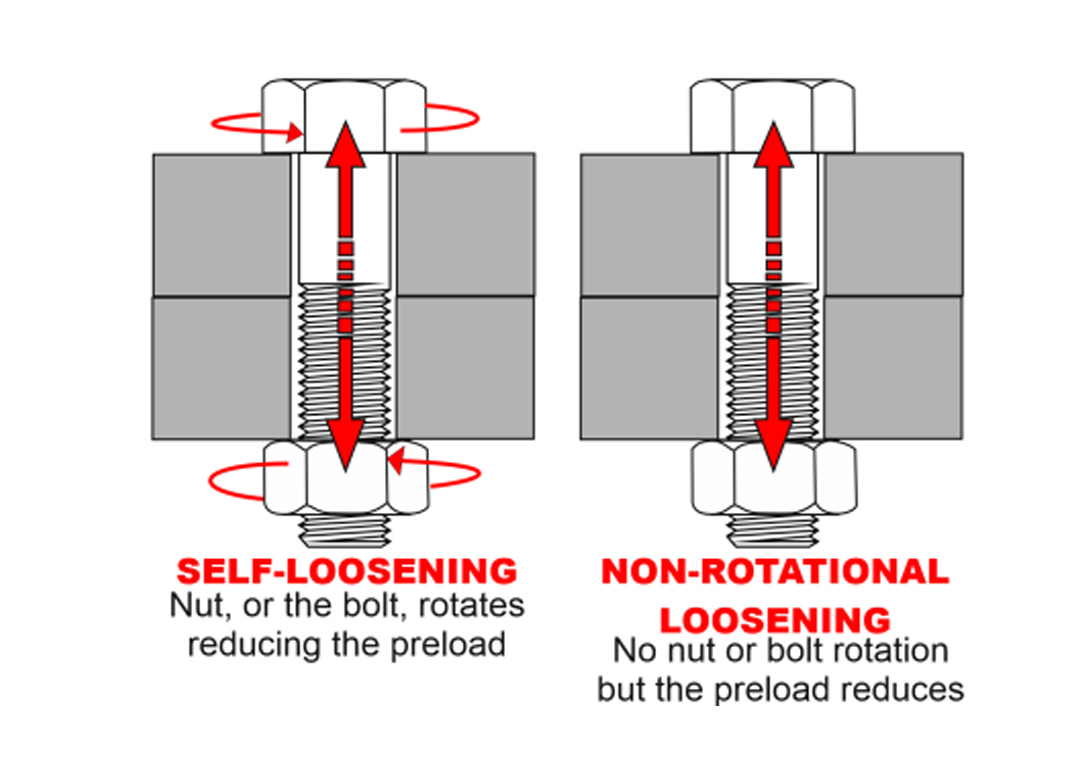
By Dr Bill Eccles, Bolt Science
This is the first part in a series of articles discussing non-rotational loosening of threaded fasteners. One feature of nuts and bolts is that they allow complex assemblies to be built and dismantled, as necessary. Under certain conditions, a nut or a bolt can come loose with obvious undesirable consequences. Self-loosening is when the nut, or bolt, rotates under the action of applied forces.
The detailed mechanisms that result in self-loosening have been a subject of research for the last sixty years and is explained elsewhere (see https://www.boltscience.com/pages/vibloose.htm). Self-loosening of threaded fasteners can lead to complete disassembly and catastrophic failure of a product. The numerous locking devices available are all trying to eliminate, or at least reduce, this possible fastener rotation.
If loosening is defined as a reduction in the preload of the fastener (preload is the tensile load in the bolt) from its initial tightened condition, then there is another type of loosening that can occur besides self-loosening. Starting now and for the next few newsletters we will be covering the issue of non-rotational loosening. Non-rotational loosening is when no relative movement occurs between the internal and external threads, that is, no rotation occurs, but a preload loss happens. A partial loss of preload tends to occur on all bolted joints, some types of joint are however more susceptible to significant loss than others.
Non-rotational loosening can occur because of deformation of the fastener itself, or the joint, following assembly. The clamp load acting on a joint exists because of the preload created from the axial extension of the fastener. Normally, the fastener extension and joint compression are elastic. After assembly, changes in the fastener extension and joint compression can lead to a preload loss occurring. The changes may be reversible, because of differential thermal expansion of the bolt to the joint, or permanent, because of plastic deformation, creep, or stress relaxation.
There are several causes of non-rotational loosening all of which involve either the bolt additionally elongating or the joint losing some compression following installation. The terms relaxation and settlement are sometimes used as coverall terms to include certain types of non-rotational loosening that can occur in the bolt and the joint. The main causes of such loosening are:
Embedding: This is localised plastic deformation that occurs under the nut face, in the joint faces and in the threads because of plastic flattening of the surface roughness.
Stress relaxation: This is a form of creep and occurs when a high stress present in a bolt is relieved over time, usually at an elevated temperature. The stress is relaxed with a subsequent reduction in the bolt’s preload.
Creep: This is the characteristic of a material to deform permanently under a condition of continual stress. Creep can occur to the joint material itself, any gaskets within the joint and any paint on the plates comprising the joint.
Excessive bearing stress: If the surface stress caused by the clamp load is too high, surface collapse occurs resulting in a loss of bolt stretch and so a loss of preload.
Differential thermal expansion: Bolts are typically tightened at ambient temperature even though they may operate at elevated or cryogenic temperatures. If the joint and bolt materials differ then the bolt preload may increase or decrease depending upon the expansion/contraction characteristics of the joint and bolt materials.
Yielding after tightening: The bolt sustaining stress beyond its yield point can occur due to differential thermal expansion or the joint sustaining a high external load. Under such circumstances, if the bolt experiences yielding, then when the external load or the temperature changes, the preload will reduce.

Having spent a decade in the fastener industry experiencing every facet – from steel mills, fastener manufacturers, wholesalers, distributors, as well as machinery builders and plating + coating companies, Claire has developed an in-depth knowledge of all things fasteners.
Alongside visiting numerous companies, exhibitions and conferences around the world, Claire has also interviewed high profile figures – focusing on key topics impacting the sector and making sure readers stay up to date with the latest developments within the industry.





